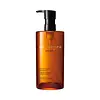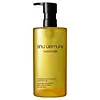What's inside
What's inside
 Key Ingredients
Key Ingredients

 Benefits
Benefits

 Concerns
Concerns

 Ingredients Side-by-side
Ingredients Side-by-side

Zea Mays Germ Oil
EmollientEthylhexyl Palmitate
EmollientCaprylic/Capric Triglyceride
MaskingIsopropyl Myristate
EmollientPolyglyceryl-10 Dioleate
EmulsifyingPolyglyceryl-6 Dicaprate
EmulsifyingPolyglyceryl-2 Oleate
EmulsifyingLimnanthes Alba Seed Oil
Skin ConditioningPhenoxyethanol
PreservativeLinalool
PerfumingSqualane
EmollientCamellia Japonica Seed Oil
EmollientSimmondsia Chinensis Seed Oil
EmollientIsopropyl Lauroyl Sarcosinate
Skin ConditioningCarthamus Tinctorius Seed Oil
MaskingDicaprylyl Ether
EmollientDicaprylyl Carbonate
EmollientTocopherol
AntioxidantGeraniol
PerfumingGlycine Soja Oil
EmollientGlyceryl Stearate Citrate
EmollientButyrospermum Parkii Butter
Skin ConditioningPhospholipids
Skin ConditioningPanax Ginseng Root Extract
EmollientBambusa Vulgaris Extract
Skin ConditioningCitric Acid
BufferingParfum
MaskingZea Mays Germ Oil, Ethylhexyl Palmitate, Caprylic/Capric Triglyceride, Isopropyl Myristate, Polyglyceryl-10 Dioleate, Polyglyceryl-6 Dicaprate, Polyglyceryl-2 Oleate, Limnanthes Alba Seed Oil, Phenoxyethanol, Linalool, Squalane, Camellia Japonica Seed Oil, Simmondsia Chinensis Seed Oil, Isopropyl Lauroyl Sarcosinate, Carthamus Tinctorius Seed Oil, Dicaprylyl Ether, Dicaprylyl Carbonate, Tocopherol, Geraniol, Glycine Soja Oil, Glyceryl Stearate Citrate, Butyrospermum Parkii Butter, Phospholipids, Panax Ginseng Root Extract, Bambusa Vulgaris Extract, Citric Acid, Parfum
Zea Mays Germ Oil
EmollientEthylhexyl Palmitate
EmollientIsopropyl Myristate
EmollientCaprylic/Capric/Succinic Triglyceride
EmollientPolyglyceryl-6 Dioleate
EmulsifyingPolyglyceryl-6 Dicaprate
EmulsifyingPrunus Armeniaca Kernel Oil
MaskingPolyglyceryl-2 Oleate
EmulsifyingPolyglyceryl-6 Caprylate
EmulsifyingLavandula Hybrida Oil
EmollientLimonene
PerfumingCitrus Nobilis Peel Oil
MaskingPelargonium Graveolens Flower Oil
MaskingLinalool
PerfumingCupressus Sempervirens Leaf/Nut/Stem Oil
EmollientTocopherol
AntioxidantCitronellol
PerfumingCitrus Limon Peel Oil
MaskingGeraniol
PerfumingOriganum Majorana Leaf Oil
MaskingZingiber Officinale Root Oil
MaskingMentha Piperita Oil
MaskingCitral
PerfumingWater
Skin ConditioningDicaprylyl Ether
EmollientDicaprylyl Carbonate
EmollientUndecane
EmollientCymbopogon Schoenanthus Oil
MaskingGlycine Soja Oil
EmollientTridecane
PerfumingGlyceryl Stearate Citrate
EmollientOryza Sativa Bran Oil
EmollientMaltodextrin
AbsorbentCitrus Junos Fruit Extract
Skin ConditioningHelianthus Annuus Seed Oil
EmollientZea Mays Germ Oil, Ethylhexyl Palmitate, Isopropyl Myristate, Caprylic/Capric/Succinic Triglyceride, Polyglyceryl-6 Dioleate, Polyglyceryl-6 Dicaprate, Prunus Armeniaca Kernel Oil, Polyglyceryl-2 Oleate, Polyglyceryl-6 Caprylate, Lavandula Hybrida Oil, Limonene, Citrus Nobilis Peel Oil, Pelargonium Graveolens Flower Oil, Linalool, Cupressus Sempervirens Leaf/Nut/Stem Oil, Tocopherol, Citronellol, Citrus Limon Peel Oil, Geraniol, Origanum Majorana Leaf Oil, Zingiber Officinale Root Oil, Mentha Piperita Oil, Citral, Water, Dicaprylyl Ether, Dicaprylyl Carbonate, Undecane, Cymbopogon Schoenanthus Oil, Glycine Soja Oil, Tridecane, Glyceryl Stearate Citrate, Oryza Sativa Bran Oil, Maltodextrin, Citrus Junos Fruit Extract, Helianthus Annuus Seed Oil
Ingredients Explained
These ingredients are found in both products.
Ingredients higher up in an ingredient list are typically present in a larger amount.
Dicaprylyl Carbonate comes from carbonic acid and caprylyl alcohol, a fatty alcohol. It is an emollient and gives skin a velvet feel. The sources of Dicaprylyl Carbonate may be synthetic or from animals.
As an emollient, Dicaprylyl Carbonate creates a film on the skin. This film traps moisture in, keeping your skin soft and hydrated.
Dicaprylyl Ether is created from caprylic acid. It is a texture-enhancer and emollient.
As an emollient, Dicaprylyl Ether is non-comedogenic. It helps soften and smooth the skin by creating a barrier on top. This barrier helps trap moisture in, helping to hydrate the skin.
Dicaprylyl Ether gives a non-greasy feel and better spreadability to products.
Learn more about Dicaprylyl EtherEthylhexyl Palmitate, also known as octyl palmitate, is created from 2-ethylhexyl alcohol and palmitic acid. It is a fatty acid ester.
The fatty acid content of Ethylhexyl Palmitate makes it an emollient. Emollients help soften and hydrate your skin by trapping moisture within.
Ethylhexyl Palmitate is also used to help improve the texture of cosmetics. It helps other ingredient dissolve in products and help disperse ingredients more evenly.
You'll likely find this ingredient in sunscreen, as it is often used to mix UV-blocking ingredients such as avobenzone and ethylhexyl triazone.
It can also help stabilize the fragrances in a product as a fragrance fixative.
Ethylhexyl Palmitate can be used to substitute mineral oil.
Due to its high fatty acid content, it may not be fungal-acne safe.
Learn more about Ethylhexyl PalmitateGeraniol is used to add fragrance/parfum to a product. It is the main component of citronellol. It is a monoterpenoid and an alcohol.
Monoterpenes are naturally found in many parts of different plants.
Geraniol can be found in many essential oils including Rose Oil and Citronella Oil. The scent of Geraniol is often described as "rose-like". Many foods also contain Geraniol for fruit flavoring.
Geraniol can irritate the skin when exposed to air. However, irritation depends on the ability of geraniol to penetrate into the skin. In general, geraniol is not able to penetrate skin easily.
Geraniol is colorless and has low water-solubility. However, it is soluble in common organic solvents.
Like citronellol, it is a natural insect repellent.
2,6-Octadien-1-ol, 3,7-dimethyl-, (2E)-
Learn more about GeraniolGlyceryl Stearate Citrate is a citric acid ester of glyceryl stearate.
It is an emulsifier, emollient, and a surfactant.
Emulsifiers help stabilize a product. It does this by preventing certain ingredients from separating. Common ingredients include oils and water, which do not mix naturally. Emulsifiers have properties that help keep ingredients such as these together.
Emollients help soothe and soften the skin. They do this by creating a protective film on your skin. This barrier helps trap moisture and keeps your skin hydrated. Emollients may be effective at treating dry or itchy skin.
Surfactants help gather oils, dirt, and other pollutants from the skin. This helps them to be easily rinsed away.
Learn more about Glyceryl Stearate CitrateGlycine Soja Oil comes from the soybean. Glycine Soja is native to eastern Asia.
Soybean oil is an emollient. It is rich in antioxidants and fatty acids including palmitic, stearic, oleic, and linoleic acids.
As an emollient, the fatty acids in soybean oil helps keep your skin soft and hydrated. It does so by creating a film on top that traps moisture in.
Soybean oil is also rich in vitamin E, a potent antioxidant. Vitamin E is also anti-inflammatory and provides a soothing effect.
Studies show soy may help fade hyperpigmentation from UVB. It does so by disrupting the melanin process from UVB induced skin inflammation.
This ingredient may not be malassezia folliculitis, or fungal-acne, safe.
Soybeans are rich in proteins and are part of the legume family. Foods made with soybeans include tofu, soymilk, edamame, miso, and soy sauce.
Learn more about Glycine Soja OilIsopropyl Myristate is an emollient, thickening agent, and texture enhancer. It is created from isopropyl alcohol and myristic acid.
It is used to help other ingredients be better absorbed. It is also an emollient and may help soften and hydrate the skin.
The comedogenic rating of this ingredient depends on the concentration. Lower amounts results in a lower rating.
Isopropyl Myristate may not be fungal acne safe. It can potentially worsen acne prone skin.
Learn more about Isopropyl MyristateLinalool is a fragrance and helps add scent to products. It's derived from common plants such as cinnamon, mint, citrus, and lavender.
Like Limonene, this ingredient oxidizes when exposed to air. Oxidized linalool can cause allergies and skin sensitivity.
This ingredient has a scent that is floral, spicy tropical, and citrus-like.
Learn more about LinaloolPolyglyceryl-2 Oleate isn't fungal acne safe.
We don't have a description for Polyglyceryl-6 Dicaprate yet.
Tocopherol (also known as Vitamin E) is a common antioxidant used to help protect the skin from free-radicals and strengthen the skin barrier. It's also fat soluble - this means our skin is great at absorbing it.
Vitamin E also helps keep your natural skin lipids healthy. Your lipid skin barrier naturally consists of lipids, ceramides, and fatty acids. Vitamin E offers extra protection for your skin’s lipid barrier, keeping your skin healthy and nourished.
Another benefit is a bit of UV protection. Vitamin E helps reduce the damage caused by UVB rays. (It should not replace your sunscreen). Combining it with Vitamin C can decrease sunburned cells and hyperpigmentation after UV exposure.
You might have noticed Vitamin E + C often paired together. This is because it is great at stabilizing Vitamin C. Using the two together helps increase the effectiveness of both ingredients.
There are often claims that Vitamin E can reduce/prevent scarring, but these claims haven't been confirmed by scientific research.
Learn more about TocopherolZea Mays Germ Oil comes from corn.
It is an occlusive skin conditioning agent.